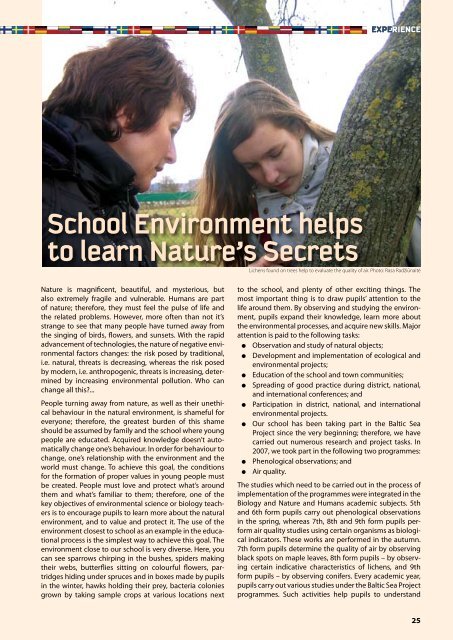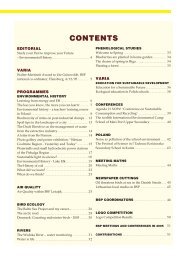newsletter_2008_1.pdf - 5.84 MB - The Baltic Sea Project
newsletter_2008_1.pdf - 5.84 MB - The Baltic Sea Project
newsletter_2008_1.pdf - 5.84 MB - The Baltic Sea Project
Create successful ePaper yourself
Turn your PDF publications into a flip-book with our unique Google optimized e-Paper software.
Nature is magnificent, beautiful, and mysterious, but<br />
also extremely fragile and vulnerable. Humans are part<br />
of nature; therefore, they must feel the pulse of life and<br />
the related problems. However, more often than not it’s<br />
strange to see that many people have turned away from<br />
the singing of birds, flowers, and sunsets. With the rapid<br />
advancement of technologies, the nature of negative environmental<br />
factors changes: the risk posed by traditional,<br />
i.e. natural, threats is decreasing, whereas the risk posed<br />
by modern, i.e. anthropogenic, threats is increasing, determined<br />
by increasing environmental pollution. Who can<br />
change all this?...<br />
People turning away from nature, as well as their unethical<br />
behaviour in the natural environment, is shameful for<br />
everyone; therefore, the greatest burden of this shame<br />
should be assumed by family and the school where young<br />
people are educated. Acquired knowledge doesn’t automatically<br />
change one’s behaviour. In order for behaviour to<br />
change, one’s relationship with the environment and the<br />
world must change. To achieve this goal, the conditions<br />
for the formation of proper values in young people must<br />
be created. People must love and protect what’s around<br />
them and what’s familiar to them; therefore, one of the<br />
key objectives of environmental science or biology teachers<br />
is to encourage pupils to learn more about the natural<br />
environment, and to value and protect it. <strong>The</strong> use of the<br />
environment closest to school as an example in the educational<br />
process is the simplest way to achieve this goal. <strong>The</strong><br />
environment close to our school is very diverse. Here, you<br />
can see sparrows chirping in the bushes, spiders making<br />
their webs, butterflies sitting on colourful flowers, partridges<br />
hiding under spruces and in boxes made by pupils<br />
in the winter, hawks holding their prey, bacteria colonies<br />
grown by taking sample crops at various locations next<br />
ExPERIEncE<br />
School Environment helps<br />
to learn Nature’s Secrets<br />
Lichens found on trees help to evaluate the quality of air. Photo: Rasa Radžiūnaitė<br />
to the school, and plenty of other exciting things. <strong>The</strong><br />
most important thing is to draw pupils’ attention to the<br />
life around them. By observing and studying the environment,<br />
pupils expand their knowledge, learn more about<br />
the environmental processes, and acquire new skills. Major<br />
attention is paid to the following tasks:<br />
● Observation and study of natural objects;<br />
● Development and implementation of ecological and<br />
environmental projects;<br />
● Education of the school and town communities;<br />
● Spreading of good practice during district, national,<br />
and international conferences; and<br />
● Participation in district, national, and international<br />
environmental projects.<br />
● Our school has been taking part in the <strong>Baltic</strong> <strong>Sea</strong><br />
<strong>Project</strong> since the very beginning; therefore, we have<br />
carried out numerous research and project tasks. In<br />
2007, we took part in the following two programmes:<br />
● Phenological observations; and<br />
● Air quality.<br />
<strong>The</strong> studies which need to be carried out in the process of<br />
implementation of the programmes were integrated in the<br />
Biology and Nature and Humans academic subjects. 5th<br />
and 6th form pupils carry out phenological observations<br />
in the spring, whereas 7th, 8th and 9th form pupils perform<br />
air quality studies using certain organisms as biological<br />
indicators. <strong>The</strong>se works are performed in the autumn.<br />
7th form pupils determine the quality of air by observing<br />
black spots on maple leaves, 8th form pupils – by observing<br />
certain indicative characteristics of lichens, and 9th<br />
form pupils – by observing conifers. Every academic year,<br />
pupils carry out various studies under the <strong>Baltic</strong> <strong>Sea</strong> <strong>Project</strong><br />
programmes. Such activities help pupils to understand<br />
25





